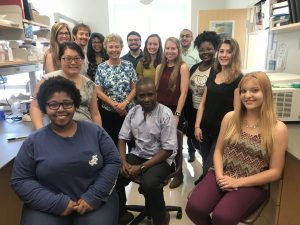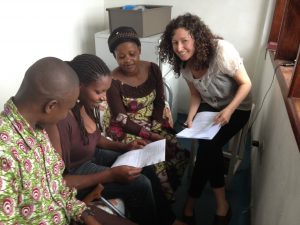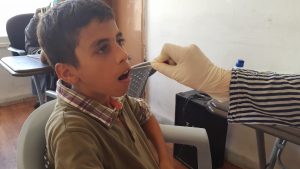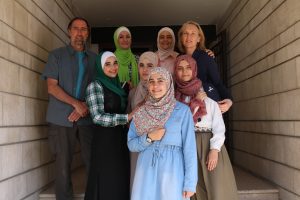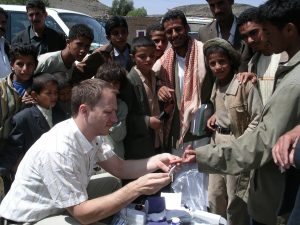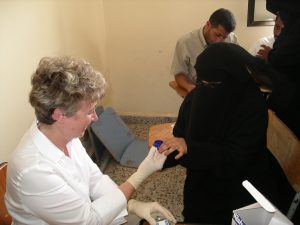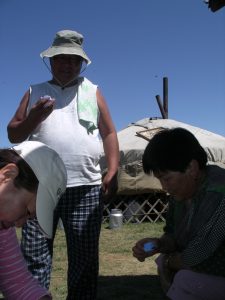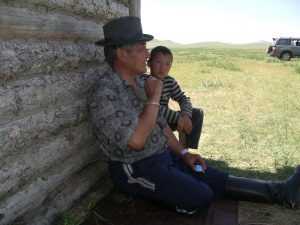Areas of Interest/Research
- Human genetics
- Epigenetics
- Complex phenotypes
- Biocultural investigation
- Impact of stress
- Risk and resilience
- Human evolution
Contribution to Science
Biocultural Investigations of Human Health and Disease
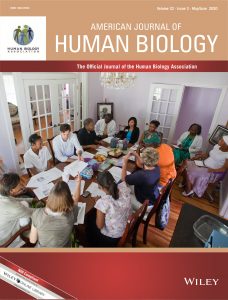 Working with Drs. Lance Gravlee and Chris McCarty, cultural anthropologists in the Department of Anthropology, we have demonstrated that integrating genetic and sociocultural data provides a more comprehensive picture of human health and disease. We have studied blood pressure variation, and other phenotype, in African Americans living in Tallahassee and in Puerto Ricans. In both studies, we detected numerous interactions between genetic and sociocultural measures that identify relevant biological and cultural factors that would not have been detected without including both types of data. Significantly, we used a novel measure of discrimination (unfair treatment of individuals close to the study participant) that is a significant predictor of blood pressure variation and interacts with genetic variants involved in psychosocial stress and mood disorders, suggesting that racial discrimination might underlie some of the racial disparities seen in complex diseases like hypertension. This research was funded by NSF grants BCS 0820687 and 1540372.
Working with Drs. Lance Gravlee and Chris McCarty, cultural anthropologists in the Department of Anthropology, we have demonstrated that integrating genetic and sociocultural data provides a more comprehensive picture of human health and disease. We have studied blood pressure variation, and other phenotype, in African Americans living in Tallahassee and in Puerto Ricans. In both studies, we detected numerous interactions between genetic and sociocultural measures that identify relevant biological and cultural factors that would not have been detected without including both types of data. Significantly, we used a novel measure of discrimination (unfair treatment of individuals close to the study participant) that is a significant predictor of blood pressure variation and interacts with genetic variants involved in psychosocial stress and mood disorders, suggesting that racial discrimination might underlie some of the racial disparities seen in complex diseases like hypertension. This research was funded by NSF grants BCS 0820687 and 1540372.
- Fuller KC, McCarty C, Seaborn C, Gravlee CC, Mulligan CJ. 2018. ACE gene haplotypes and social networks: Using a biocultural framework to investigate blood pressure variation in African Americans, PLoS ONE, 13:e0204127
- Quinlan J, Pearson LN, Clukay CJ, Mitchell MM, Boston Q, Gravlee CC, Mulligan CJ.2016. Genetic loci and novel discrimination measures associated with blood pressure variation in African Americans living in Tallahassee, PLoS ONE, 11(12):e0167700.
- Boulter AC, Quinlan JA, Miró-Herrans AT, Pearson L, Todd NL, Gravlee CC, Mulligan CJ. 2015. Interaction of Alu polymorphisms and novel measures of discrimination in association with blood pressure in African Americans living in Tallahassee, Hum Biol 87(4):295-305.
- Gravlee CC, Non AL, Mulligan CJ. 2009. Genetic ancestry, social classification, and racial inequalities in blood pressure in Southeastern Puerto Rico, PLoS ONE, 4(9):e6821.
Epigenetic Markers of Psychosocial Stress
My research in the Democratic Republic of Congo has provided some of the first evidence that psychosocial stressors, such as sexual violence, can leave an epigenetic imprint (specifically DNA methylation) that may influence health outcomes and may be transmitted to future generations. We study new mothers and their newborns in the Democratic Republic of Congo, where ongoing civil war and its aftermath has created one of the most traumatic environments in the world for women. We find that maternal stress is associated with a genome-wide change in methylation in mothers, but a more focused, gene-specific effect on methylation in newborns. A change in methylation at particular genes in newborns that is not seen in mothers is consistent with the Developmental Origins of Health and Disease (DOHaD) hypothesis in which maternal stress modifies offspring biology. Our research suggests that events experienced during one’s life may leave an epigenetic imprint that may impact gene expression in future generations. This research is funded by NSF grants BCS 1231264 and 1540372.
- Mulligan CJ. 2016. Early environments, stress, and the epigenetics of human health, Annual Review Anthro, 45:233-249.
- Kertes DA, Kamin HS, Hughes DA, Rodney NC, Mulligan CJ. 2016. Prenatal maternal stress predicts methylation of genes regulating the hypothalamic-pituitary-adrenocortical system in mothers and newborns, Child Development, special issue on “Epigenetics in Child and Adolescent Development”, 87:61-72.
- Rodney NC and Mulligan CJ. 2014. A biocultural study of the effects of maternal stress on mother and newborn health in the Democratic Republic of Congo, Amer J Phys Anthropol, 155(2):200-209.
- Mulligan CJ, D’Errico NS, Stees J, Hughes DA. 2012. Methylation changes at NR3C1 in newborns associate with maternal prenatal stress exposure and newborn birthweight, Epigenetics, 7:853-857, doi: 10.4161/epi.21180.
Epigenetic signatures of trauma and stress in multi-generational Syrian refugee families
This project is the first to test in humans for an epigenetic signature of exposure to violence trauma while pregnant that is transmitted intergenerationally. Three groups of three-generation Syrian families with contrasting exposures to war violence will be compared; grandmothers in the 1980 exposure group were pregnant during the 1980-1982 conflict in Hama, mothers in the 2011 exposure group were pregnant during the 2011-2013 conflict, and control families lived in Jordan prior to either conflict. Trauma exposure data and biological samples have been collected from grandmothers, mothers, index child, and older sibling to enable us to test for an epigenetic signature of direct, prenatal, and germline exposures to violence trauma. Collaborators Catherine Panter-Brick (Dept of Anthropology, Yale University) and Rana Dajani (Dept of Biology, Hashemite University, Zarqa, Jordan) have collected data on trauma exposures and biological samples from intergenerational (three generations) Syrian refugee families to test multiple combinations of direct and in utero exposure to violence trauma. Collaborator Alexandra Binder (Cancer Center, University of Hawai’i) is an expert on the analysis of DNA methylation data. Graduate student Edward Quinn is in charge of generating and analyzing the DNA methylation data.
- This work is supported by NSF grant BCS 1849379 “Intergenerational impact of violence exposure during pregnancy on epigenetic change”.
Migration of Anatomically Modern Humans out of Africa
In collaboration with archaeologists in the department, I became interested in identifying the route by which the first anatomically modern humans left Africa and successfully colonized the rest of the planet. We have compared genetic support for migration routes along the northern vs southern extent of the Red Sea. Using the largest set of samples collected from Yemen, the first step along the southern migration route, we have determined that multiple migrations out of, and back into, Africa have erased most of the signals of the first migration out of Africa. We have also investigated introgression of archaic DNA into the modern human gene pool and find strikingly similar levels of Neanderthal introgression throughout the Arabian Peninsula. This research was funded by NSF grants BCS 0518530 and 1258965.
- Vyas D, Kitchen A, MIró-Herrans AT, Pearson L, Al-Meeri A, Mulligan CJ, 2016. Bayesian analyses of Yemeni mitochondrial genomes suggest multiple migration events with Africa and Eurasia, Am J Phys Anthropol, 159:382-393.
- Miró-Herrans AT, AL-Meeri A, Mulligan CJ. 2014. Human migration patterns in Yemen and implications for reconstructing prehistoric population movements. PLoS ONE, 9(4): e95712.
- Hodgson JA, Mulligan CJ, Al-Meeri A, Raaum R. 2014. Early back-to-Africa migration into the Horn of Africa, PLoS Genetics, 10(6):e1004393.
- Kitchen A, Ehret D, Assefa S, Mulligan CJ. 2009. Bayesian phylogenetic analysis of Semitic languages identifies an Early Bronze Age origin of Semitic in the Near East, Proc R Soc B 276:2703-10
- Cerný V, Mulligan CJ, Rídl J, Zaloudková M, Edens CM, Hájek M, Pereira L. 2008. Regional differences in the distribution of the sub-Saharan, West Eurasian, and South Asian mtDNA lineages in Yemen, Am J Phys Anthropol, 136:128-137.
Peopling of the New World
Before I came to UF, my research provided some of the first evidence to suggest that the New World was colonized by a single wave of migration that most likely originated in east Central Asia around Mongolia. While at UF, my colleagues and I have expanded that model to specify three separate stages of migration that include an extended period of population isolation and genetic differentiation on Beringia. Specifically, we propose that Amerinds first diverged from the Asian gene pool about 40,000 years ago, occupied Beringia for approximately 10,000 years, and then rapidly expanded in the New World approximately 16,000 years ago. Expansion into the New World was accomplished by a large population increase that reached the southern tip of South America within several thousand years.
- Mulligan CJ, Szathmáry EJE. 2017. The peopling of the Americas and the origin of the Beringian occupation model, Am J Phys Anthropol, 162: 403-408.
- Mulligan CJ, Kitchen A, Miyamoto MM. 2008. Updated three-stage model for the peopling of the Americas, PLoS ONE, 3(9):e3199.
- Kitchen D, Miyamoto MM, Mulligan CJ. 2008. A three-stage colonization model for the peopling of the Americas, PLoS ONE, 3(2):e1596.
Research Support
Ongoing Research Support
NSF-BCS-1849379
- “Intergenerational impact of violence exposure during pregnancy on epigenetic change”
- $348,333
- 8/01/19-7/31/21 (PI)
NSF-BCS-1826885
- “Workshop: Advancing data management and sharing practices in the anthropological sciences”
- $48,300
- 8/15/18-7/31/19 (Co-PI)
NSF-BCS-1719866
- “Epigenetic alterations, gene expression, and stress among new mothers and neonates in the Democratic Republic of Congo: A biocultural investigation of the intergenerational effects of stress”
- $499,446
- 02/01/17-01/31/19 (PI)
Recently Completed Research Support
NSF BCS-1448213
- “US/UK workshop on social and behavioral epigenetics”
- $48,940
- 6/15/14-5/31/15 (PI)
NSF BCS-1231264
- “Epigenetic alterations and stress among new mothers and neonates in the Democratic Republic of Congo: A biocultural investigation of the intergenerational effects of war”
- $353,328
- 08/01/12-07/31/14 (PI)
NSF BCS-0820687
- “Genetic ancestry, race and health disparities: A biocultural approach”
- $391,586
- 7/15/08-7/14/11 (PI)
NSF BCS-0518130
- “Human dispersals out of Africa: Mitochondrial and Y chromosomal genetic analysis of Eritrean and Omani populations”
- $311,708
- 7/29/05-7/28/08 (PI)
